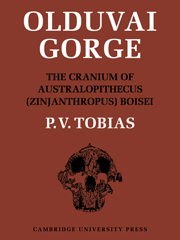Book contents
- Frontmatter
- Contents
- List of text-figures
- List of plates
- List of tables
- Introductory Note
- Foreword
- Editor's Note
- Acknowledgements
- I Introduction
- II Preservation and reconstruction of the cranium
- III The cranial vault
- IV The basis cranii externa
- V Certain critical angles and indices of the cranium
- VI The interior of the calvaria
- VII The thickness of the cranial bones
- VIII The endocranial cast of Zinjanthropus
- IX Metrical characters of the calvaria as a whole
- X The structure of the face
- XI The pneumatisation of the Zinjanthropus cranium
- XII The dental arcade and the palate
- XIII The pattern of dental attrition and occlusion, with comments on enamel hypoplasia
- XIV The size of individual teeth, absolute and relative
- XV The size of the dentition as a whole
- XVI The crown shape index of the teeth
- XVII The morphology of the teeth
- XVIII Summary of cranial and dental features of Zinjanthropus
- XIX The taxonomic status of Zinjanthropus and of the australopithecines in general
- XX The cultural and phylogenetic status of Australopithecus boisei and of the australopithecines in general
- References
- Index of persons
- Index of subjects
- Plate section
XVIII - Summary of cranial and dental features of Zinjanthropus
Published online by Cambridge University Press: 05 November 2011
- Frontmatter
- Contents
- List of text-figures
- List of plates
- List of tables
- Introductory Note
- Foreword
- Editor's Note
- Acknowledgements
- I Introduction
- II Preservation and reconstruction of the cranium
- III The cranial vault
- IV The basis cranii externa
- V Certain critical angles and indices of the cranium
- VI The interior of the calvaria
- VII The thickness of the cranial bones
- VIII The endocranial cast of Zinjanthropus
- IX Metrical characters of the calvaria as a whole
- X The structure of the face
- XI The pneumatisation of the Zinjanthropus cranium
- XII The dental arcade and the palate
- XIII The pattern of dental attrition and occlusion, with comments on enamel hypoplasia
- XIV The size of individual teeth, absolute and relative
- XV The size of the dentition as a whole
- XVI The crown shape index of the teeth
- XVII The morphology of the teeth
- XVIII Summary of cranial and dental features of Zinjanthropus
- XIX The taxonomic status of Zinjanthropus and of the australopithecines in general
- XX The cultural and phylogenetic status of Australopithecus boisei and of the australopithecines in general
- References
- Index of persons
- Index of subjects
- Plate section
Summary
The cranial vault
The curvature and components of the vault
(1) The parieto-occipital plane of Zinjanthropus rises steeply from the external occipital protuberance. The vault of Australopithecus is more evenly curved in this area.
(2) The parietotemporal side-walls of the vault also rise steeply, contributing to the full, rounded character of the vault. This feature finds a parallel in the latest cranium of Australopithecus from Makapansgat, MLD 37/38.
(3) The vault of Zinjanthropus, as seen in norma verticalis, is long-spheroid, whereas that of the reconstructed Paranthropus is short-spheroid and that of Australopithecus long-ovoid. Zinjanthropus is intermediate in this respect between the two South African forms, though approaching more closely to the second reconstruction of Paranthropus.
(4) Most dimensions of the parietal bones in Zinjanthropus fall within the range of variation of Australopithecus, while a few dimensions exceed the range. In anteroposterior extension, the australopithecine parietal is slightly smaller than that of Homo erectus, whereas, in mediolateral extension, the australopithecine parietal is far smaller than that of H. erectus. In contradistinction, the anteroposterior extent of the parietal bone in pongids is far smaller than in australopithecines.
(5) The chord-arc indices of the edges of the parietal bones show that in Zinjanthropus, the parietal bone is slightly less curved along the coronal margin than in Australopithecus. The anteroposterior curvature of the parietal bones of Australopithecus tends to be greater, and the mediolateral curvature less, than in H. erectus.
- Type
- Chapter
- Information
- Olduvai Gorge , pp. 193 - 218Publisher: Cambridge University PressPrint publication year: 1967



